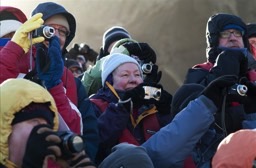Dat on assignment in Bhutan
Dat captures the rare and endangered wildlife of Bhutan as the winner of our 2010 Travel Photography Scholarship
Winner Photography Scholarship 2010
Dat's assignment was to capture the wildlife of the Phobjikha Valley, including the rare White Bellied Heron, of which there are only 200 left in the world.
Do Chula Pass
After packing up our luggage, we parted Thimphu and drove to Phobjikha valley. On the way, we stopped at the Do Chula pass (3150 m), where we could view the Himalayan range and Gangkar Puensum, the world’s highest un-climbed mountain. For the Bhutanese people, mountains are respected as deities, so no expedition to any mountain has ever been allowed in Bhutan. We tried to photograph its peak, but unluckily, a cloud covered it. Behind that Himalayan range is the border between Bhutan and China.
Just as Mr. Khashapa predicted, we spent more than 3 hours at the Do Chula Pass because there were so many things to photograph and document about. There were 108 Chortens built by the forth King for the well-being of the public. Nearby them was literally a forest of prayer flags. It took so long to photograph all because we were camping for the sun to come out of the cloud. When the sun shone onto the prayer flags, complex and colourful textures appeared beautifully. I had to climb onto one tree to catch a clearer view of the flags.

Phobjikha to Punakha
On our way from Phobjikha to Punakha, we went past lots of things and happenings. First were a group of mountain bulls and some shield bugs. Second was a roadblock with huge landslide. Third was a busy town that was going to be abandoned. We stopped for long at this town to catch some stories about it for the last time before it disappeared. Because of its location near to a monastery, the public businesses caused much disturbance to the monks at the monastery. I could see this easily from the presence of the monks hanging around in the town. Jason gave me a 10-minute assignment to come up with a cover photo, some story photos and a closing photo. It was really thrilling to work in such time constraints.

Lost in Bhutan
Today was a very special day of the trip. We woke up at 4.30 am to go and photograph the White Bellied Hereon. Much rarer than the Black Necked Cranes, these birds had a humble population of only 26 in Bhutan. According to an ecologist that we met on the way, the construction of hydro power plants had been disrupting the lives of these birds because they drove their predators to the small rivers where the birds laid their eggs.
As we could only spot one bird and I did not have a tele lens powerful enough, I decided to wander around and looked for a story about the people living by the river. I came across a lady who worked in the field since as early as 5.00 am till noon. Also, I joined a group of kids for an exciting dart-throwing game. While I was doing all these, Jason got some fantastic close-up shots of the highly sensitive bird.

 Photography 2010
Photography 2010
About the Opportunity
Dat won a 7-day all-expenses-paid photographic assignment to Bhutan and was mentored by National Geographic photographer Jason Edwards.
See the results Winning entry
Winning entry
Ngoc's world
Through his poignant and uplifting series of images Dat has shown us a place in the world occupied by a child and her everyday triumphs.
